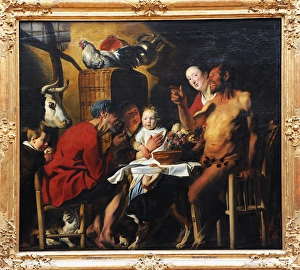1593 1678 Collection
Jacob Jordaens (1593-1678) was a renowned Flemish Baroque painter whose works showcased his exceptional talent and versatility
All Professionally Made to Order for Quick Shipping
Jacob Jordaens (1593-1678) was a renowned Flemish Baroque painter whose works showcased his exceptional talent and versatility. In "Mercury Killing Argus" (1652), Jordaens masterfully depicted the dramatic moment when Mercury slays the hundred-eyed giant, Argus. The artist's attention to detail and skillful use of light and shadow create a captivating scene. Another notable work by Jordaens is "Jupiter Nourished by the Goat Almathea" (1652). This painting portrays the mythological tale of Jupiter being raised by a goat named Almathea. Through vibrant colors and intricate composition, Jordaens brings this enchanting story to life. "The Betrayal of Christ, " created in the late 1650s, showcases Jordaens' ability to convey deep emotions through his art. This poignant piece depicts Judas betraying Jesus with a kiss, capturing the anguish felt during this pivotal moment in Christian history. In "The Conversion of Saul with Horseman and Banner" (c. 1645-1647), Jordaens explores themes of religious transformation as he portrays Saul's conversion on his way to Damascus. The inclusion of horsemen and banners adds an element of grandeur to this spiritual event. Similarly, "The Conversion of Saul with Christ and the Cross" (c. 1645-1647) delves into Saul's profound encounter with Christ that led to his transformation into Paul, one of Christianity's most influential figures. With meticulous brushwork and evocative symbolism, Jordaens captures both the physicality and spirituality inherent in this biblical narrative. Throughout his career, Jacob Jordaens demonstrated remarkable artistic prowess across various subjects ranging from mythology to religion. His ability to breathe life into stories such as Prometheus Bound exemplifies his mastery over Greek mythology while showcasing his unique interpretation.











